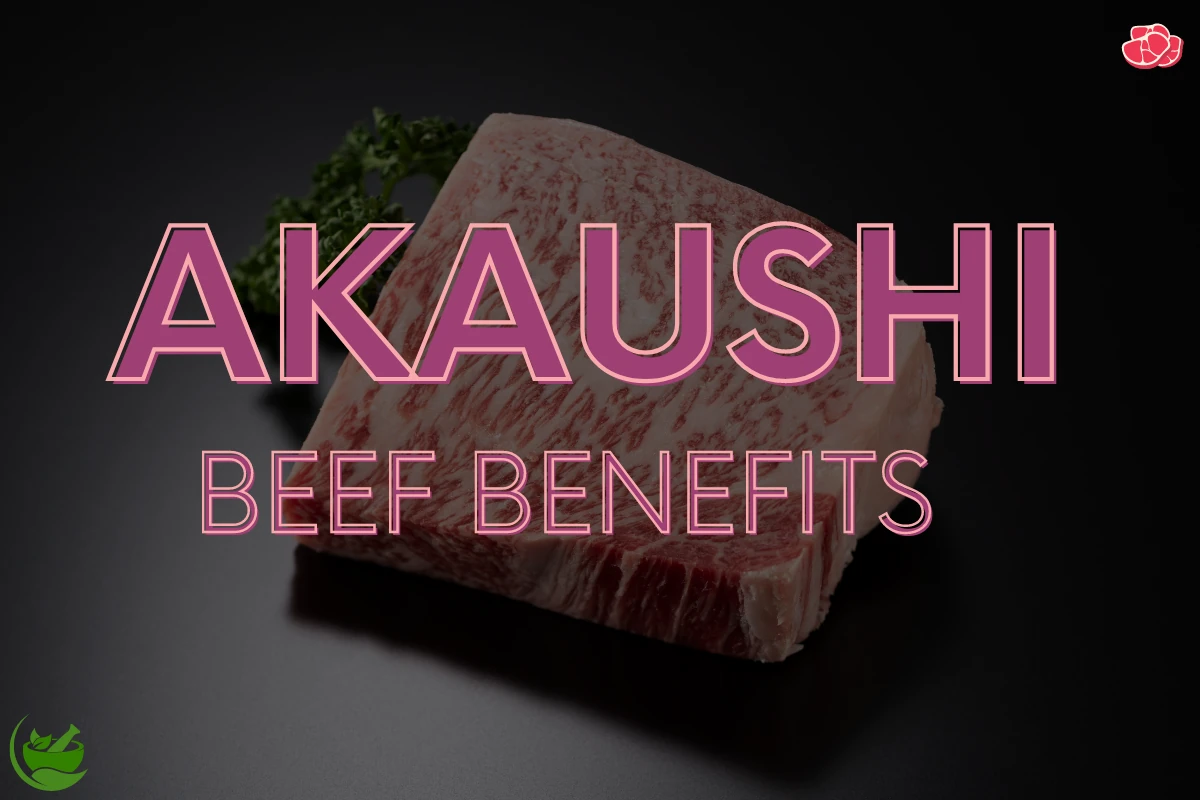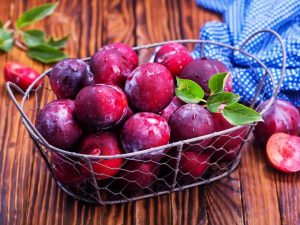Akaushi Beef Health Benefits
Akaushi refers to a specific breed of cattle that originates from Japan. It’s a sub-type of the Japanese Brown Cow and is highly regarded for its superior meat quality. Akaushi cattle are known for their exceptional marbling, contributing to beef’s tenderness, richness, and flavor. The breed has gained recognition and appreciation for its high-quality meat, particularly its tenderness, taste, and health benefits.
Akaushi Beef Cattle: History
Japanese Akaushi Breed
Akashi beef cattle, also known as Akashiyaki, are a breed of cattle native to the Akashi region of Japan. This breed has a long history from the Edo period (1603–1868).
They were being used primarily for agricultural and beef purposes. Over time, selective breeding with specific rearing techniques has enhanced the quality of the meat, having exceptional tenderness, flavor, and marbling. These extraordinary qualities have placed it among top-tier Wagyu beef brands in Japan.
America’s Akaushi Breed
The Akashi cattle, originating in Japan, were introduced to the United States in the late 20th century. But not in the way of massive live cattle import to America due to stringent regulations on importing live cattle from Japan.
Nevertheless, there have been efforts to preserve the characteristics of the Akashi breed by crossbreeding with other cattle breeds in the U.S. to replicate the quality and marbling of Akashi beef. The cattle’s meat quality is attributed to genetics, diet, and the environment in which they are raised.
The American Wagyu Association played a significant role in crossbreeding Akashi cattle with American cattle breeds. As a result of these efforts, American Wagyu, a crossbred cattle breed possessing many desirable characteristics of the Akashi breed, was successfully developed. These crossbred cattle have gained popularity in the U.S. for their high-quality, marbled meat, enabling Akaushi beef health benefits.
Akaushi and General Beef Comparison
Akaushi beef’s health benefits depend on the specific bio-active compounds, differentiating it from general beef cattle breeds. A comparison of these two breeds is presented here:
Akaushi Breed
- Marbling: Akaushi cattle are highly valued for their exceptional marbling, producing tender and flavorful meat.
- Health benefits: Their meat contains higher levels of monounsaturated fats and Oleic acid, often associated with health benefits.
- Distinctive taste: Akaushi beef is renowned for its rich, buttery flavor due to its unique fat composition.
- Pricing: Akaushi beef is considered a luxury beef and is often more expensive than general beef due to its superior quality and the strict standards of its production.
- Bio-active Compounds: Akaushi beef is known for its higher concentration of monounsaturated fats and a specific fatty acid called Oleic acid, which can offer potential health benefits. These components contribute to its rich, buttery texture and potential cardiovascular advantages.
General Beef Cattle
- Adaptability: General beef cattle breeds are often bred for various climates and environments, making them adaptable to different conditions.
- Diverse breeds: There are numerous breeds, each with its characteristics in size, meat quality, and environmental suitability.
- Varied uses: Beef cattle are primarily raised for their meat, but some breeds might also be utilized for their hides (leather), milk, or, in specific regions, for drafting purposes. (pulling the carts, etc.)
- Pricing: The pricing of general beef can vary significantly based on the cut, quality, and region. which includes commonly available cuts like sirloin, rib-eye, or chuck, which tend to be more affordable and widely accessible worldwide compared to more premium or specialty beef like Akaushi beef.
- Bio-active Compounds: General beef typically contains various nutrients such as protein, iron, zinc, and B vitamins. It also contains saturated fats, which are found in varying amounts depending on the cut and quality of the meat. Additionally, it contains amino acids and creatine, which are essential for muscle function and energy production.
These differences highlight the unique characteristics of Akaushi cattle, particularly their meat quality, compared to the broader category of general beef cattle. This category covers a more comprehensive array of breeds with varying characteristics and uses. Comparative Akaushi health benefits are available due to specific traits of Akaushi beef.
Akaushi Beef Health Benefits
Akaushi beef’s health benefits are more than those of general meat. The unique characteristics of this breed and its rarity make it a luxurious beef. The health benefits of Akaushi beef are listed here:
Healthier Fats
Akaushi beef contains a high monounsaturated fat content, particularly oleic acid, which is believed to have positive effects on heart health and cholesterol levels.
Omega-3 Fatty Acids
It is richer in omega-3 fatty acids compared to other types of beef. Omega-3s are known for their anti-inflammatory properties and contribution to heart and brain health.
Lower Saturated Fats
Akaushi beef tends to have lower saturated fat content than conventional beef, which may benefit heart health and reduce the risk of cardiovascular diseases.
High Conjugated Linoleic Acid (CLA)
Akaushi beef contains a higher concentration of CLA, a fat type associated with various health benefits, including potential anti-cancer properties and weight management.
Rich in Protein
Akaushi beef, like other beef varieties, is an excellent source of high-quality protein, essential for muscle building, repair, and overall body function.
Iron and Essential Nutrients
It provides essential nutrients such as iron, zinc, and B vitamins, which are crucial for various bodily functions like red blood cell production and energy metabolism.
No Hormones or Antibiotics
Akaushi cattle are often raised without hormones or antibiotic supplements, making it a more natural and potentially healthier option for consumers concerned about additives in their meat.
Akaushi Beef: Culinary Uses and Cooking Methods
Akaushi beef offers various cuts, each suitable for different cooking methods. Here’s a breakdown of some popular cuts and their recommended cooking methods:
- Rib-eye: This well-marbled cut excels when grilled or pan-seared, guaranteeing a juicy, flavorsome steak. Target a medium-rare to medium doneness for optimal results to retain its tenderness and rich taste.
- Filet Mignon: This cut suits those who prefer leaner beef. Optimal cooking involves quick, high-heat methods like grilling, broiling, or pan-searing to safeguard its tenderness and subtle flavor.
- Sirloin: A versatile cut adaptable to grilling, pan-searing, or roasting, providing a delicate balance of flavor and tenderness. Enhance its tenderness by slicing against the grain post-cooking.
- Chuck Roast: Ideal for slow-cooking methods such as braising or stewing, benefiting from prolonged, moist cooking to break down connective tissues and yield a luscious, flavorful dish.
- Brisket: Renowned for its robust flavor, brisket thrives when smoked, braised, or slow-roasted, requiring extended low-temperature cooking to achieve desired tenderness.
- Short Ribs: Perfect for braising or slow-cooking, ensuring tender, succulent meat. The marbling enhances the rich, beefy flavor in slow-cooked dishes.
- Flank Steak: Best suited for marination and quick grilling or high-heat cooking, emphasizing the importance of slicing against the grain for utmost tenderness.
- Tenderloin: Renowned for its tenderness, the tenderloin, often used for fillet mignon, benefits from quick, high-heat methods like grilling, broiling, or pan-searing to maintain its tenderness and delicate flavor profile.
- Strip Steak (New York Strip): A flavorful cut, ideal for grilling or pan-searing. Its moderate marbling guarantees a rich taste and tenderness. Cook to medium-rare or medium for the best dining experience.
- T-Bone Steak: Featuring a T-shaped bone with meat on both sides—tenderloin on one and strip steak on the other—this cut is perfect for grilling or broiling, offering a combination of tenderness and robust flavor.
- Skirt Steak: Often used in fajitas, this cut shines when marinated and quickly grilled or seared over high heat. Slicing against the grain post-cooking ensures a tender bite.
- Round Steak: Typically leaner, this cut benefits from marination or tenderizing before grilling or pan-searing. Slicing thinly against the grain helps maximize tenderness.
- Rump Roast: Ideal for roasting or slow-cooking methods like braising. A longer cooking time at lower temperatures ensures tenderness and a rich, beefy flavor.
- Eye of Round: Lean and economical, this cut works well for roasting or braising. Slicing thinly against the grain post-cooking enhances its tenderness for roast beef or beef sandwich recipes.
Each cut has unique characteristics and flavors, and the cooking methods recommended for each aim to bring out the best taste and tenderness. Feel free to explore different recipes and cooking techniques to discover your favorite way of preparing these cuts! For a unique recipe using one of these cuts, consider a special preparation:
Recipe: Grilled Rib-eye Steak with Herb Butter
Ingredients: Rib eye steaks, salt, pepper, olive oil, fresh herbs (such as rosemary, thyme, and parsley), butter
Instructions:
- Sprinkle a generous amount of salt and pepper over the rib eye steaks. Allow them to rest at room temperature for about half an hour before cooking.
- Preheat your grill to high heat.
- Rub the steaks with olive oil and place them on the grill. Grill or pan-sear the steaks for approximately 4-5 minutes on each side to achieve a medium-rare level of doneness.
- While the steaks are grilling, mix softened butter with finely chopped fresh herbs (rosemary, thyme, and parsley).
- Once the steaks are cooked, remove them from the grill and rest for a few minutes.
- Top each steak with a generous dollop of herb butter and let it melt over the hot steak.
- Serve the rib-eye steaks with your choice of sides, and enjoy!
This recipe enhances the natural flavors of the rib-eye steak with simple herb butter, making it a unique and delicious dish.
Research work on Akaushi Breed
Topic: “PSXI-18 Influence of Akaushi Genetics on Beef Performance and Carcass Merit in Grain and Grass-finishing Systems”
Research on the above topic was conducted, which has been summarized here :
Types of cows and their diets affect beef production. They compared Red Angus cows with a mix of Red Angus and Akaushi cows. The cows were fed either grass or a special grain diet.
They found that cows eating the grain diet gained more weight and had more significant portions of meat and more fat. The cows with Akaushi genes had some advantages, too, especially when eating the grain diet.
In simpler terms, the study showed that eating certain cows on certain diets can make beef tastier and bigger but also fattier. The type of cow and what they eat play a big role in how beef turns out. Source.
2. “Fatty Acid and Micronutrient Profile of Longissimus Lumborum from Red Angus and Red Angus x Akaushi Cattle Finished on Grass or Grain”
More research was conducted on the above topic. The summary is given here:
This study compared beef’s fat and nutrient levels from two types of cows (a Red Angus and a Red Angus x Akaushi mix) that ate either grass or grains. They found that beef from cows that ate grass had more good fats like omega-3s and specific vitamins and minerals like iron and vitamin E. The type of cow had some effect, too, with the mix containing more certain fatty acids and nutrients. But overall, what the cows ate had a more significant impact on the beef’s nutrition than the type of cow. Eating beef from grass-fed cows might be healthier for people because of its better fats and nutrients. Source.
Grass-fed vs. Grain-fed Akaushi Beef: Health Benefits and Taste
Health Benefits
- Grass-fed Akaushi Beef generally has slightly higher levels of omega-3 fatty acids and beneficial antioxidants from the grass they eat. Omega-3 may contribute to potential heart health benefits and a slightly different nutritional profile.
- Grain-fed Akaushi Beef: Often perceived as having more marbling due to the grain-based diet, resulting in a richer taste. While it may have slightly lower omega-3 levels, it can still provide essential nutrients. The diet may lead to a different balance of fats, impacting taste and texture.
Taste
- Grass-fed Akaushi Beef tends to have a more nuanced taste than grain-fed beef.
- Grain-fed Akaushi Beef: Often praised for its rich, buttery taste owing to the higher marbling resulting from the grain diet. This marbling enhances tenderness and can provide a more intense beefy flavor.
Understanding these differences allows consumers to consider their preferences. Grass-fed Akaushi beef might offer a different nutritional composition, potentially emphasizing certain health benefits from the grass diet. Grain-fed Akaushi beef, on the other hand, might lean towards a richer taste due to higher marbling from the grain-based diet. It’s about balancing health considerations and taste preferences when choosing between these options.
Consumer Guide to Akaushi Beef
Choosing the right Akaushi beef might seem puzzling, but a few tips can make it straightforward. It’s like having a guide to find something special in a store. The key is to know where to look and what labels to check on the beef packaging. Here are some essential points when selecting Akaushi beef for its desired taste and nutrients.
Locating Akaushi Beef: Essential Tips
Finding Akaushi beef might require exploring specialty butcher shops, upscale restaurants, or farms directly associated with Akaushi cattle production. Some online retailers or local markets focusing on high-quality meats might offer Akaushi beef. Contacting local agricultural associations or specialty meat distributors could also provide leads on its availability in specific regions.
Identifying Authentic Akaushi Beef
- Labeling and Certifications: Look for labels or certifications indicating “Akaushi” or “American Wagyu Association” to ensure authenticity. Some may also carry specific grades like “A5” to denote the highest quality.
- Marbling and Color: Akaushi beef is known for its high marbling and evenly distributed fat within the meat. The color tends to be a deep red with creamy white marbling.
- Packaging Information: Check for packaging details mentioning the breed, the producer, or any specific information related to Akaushi beef origin.
Confirming Authenticity: Akaushi Beef
- Traceability: Seek information on the beef’s origins, including the farm or ranch where the cattle were raised. Reputable sellers often provide details about the source of their Akaushi beef.
- Certifications and Documentation: Look for official certifications or documentation from recognized organizations, ensuring the beef’s authenticity. These might include documentation from breed associations or quality certifications.
- Supplier Reputation: Research the reputation of the supplier or retailer. Trusted sellers often have a history of providing authentic, high-quality Akaushi beef and may have positive reviews or testimonials.
Ensuring the authenticity of Akaushi beef involves:
- A combination of attentive sourcing.
- Understanding labeling or grading systems.
- Verifying information provided by suppliers.
Consumers may benefit from engaging with trusted sellers, seeking information on beef origins, and being mindful of quality indicators like marbling and specific certifications.
Bottom Lines
Akaushi beef is a unique meat known for its fantastic taste and tenderness. These cows have healthier fats, like Oleic acid, which is good for your heart. Plus, they’re rich in omega-3s and have less bad fat than regular beef, which might help your heart stay healthy. Akaushi beef also has nutrients like iron, zinc, and protein your body needs. These cows are raised without hormones or antibiotics, making their meat a more natural choice. Originally from Japan, they’ve been brought to the U.S., where they’ve been crossbred to keep their characteristics.







